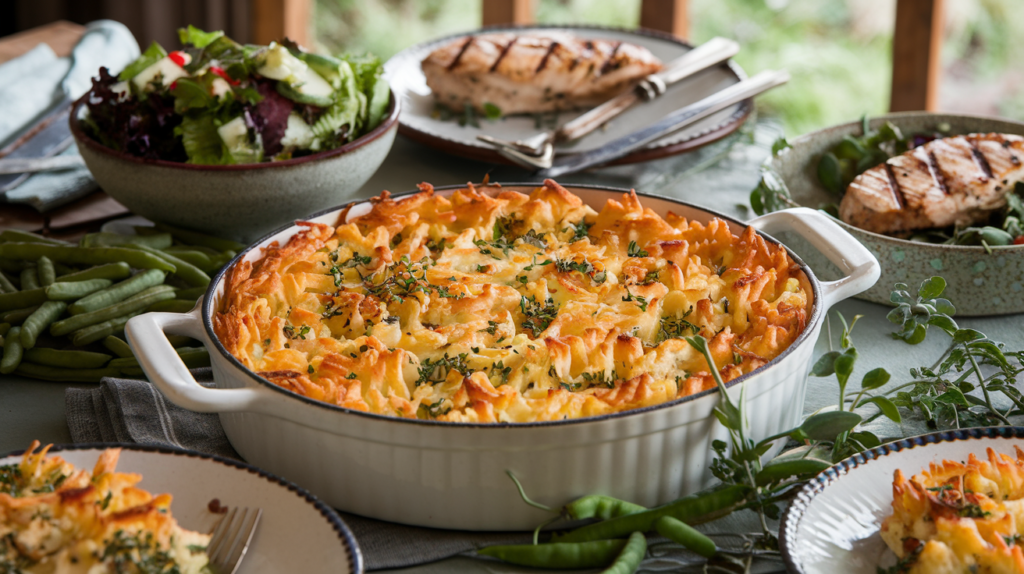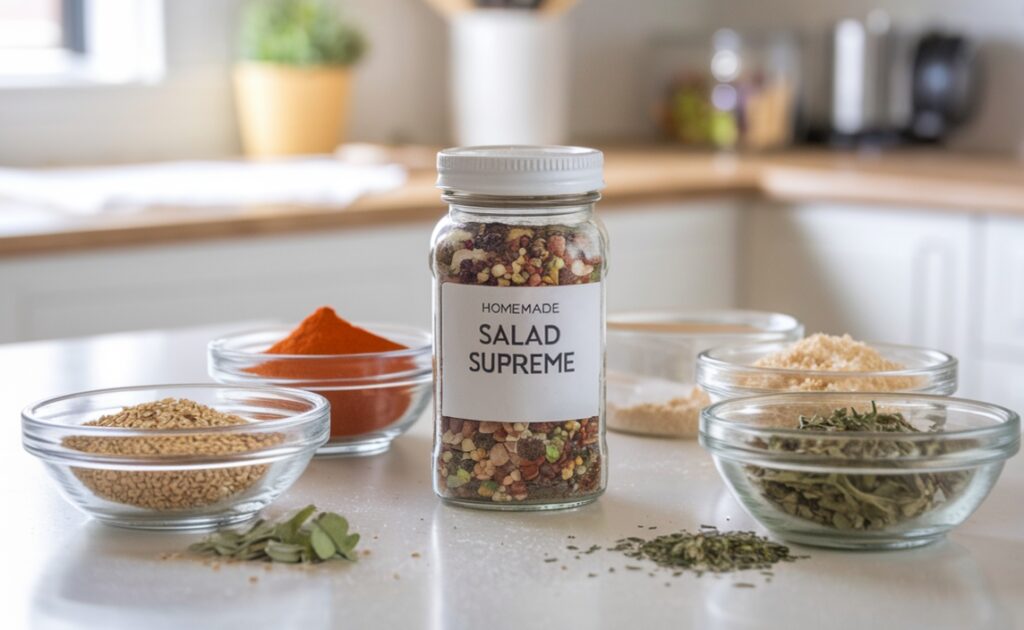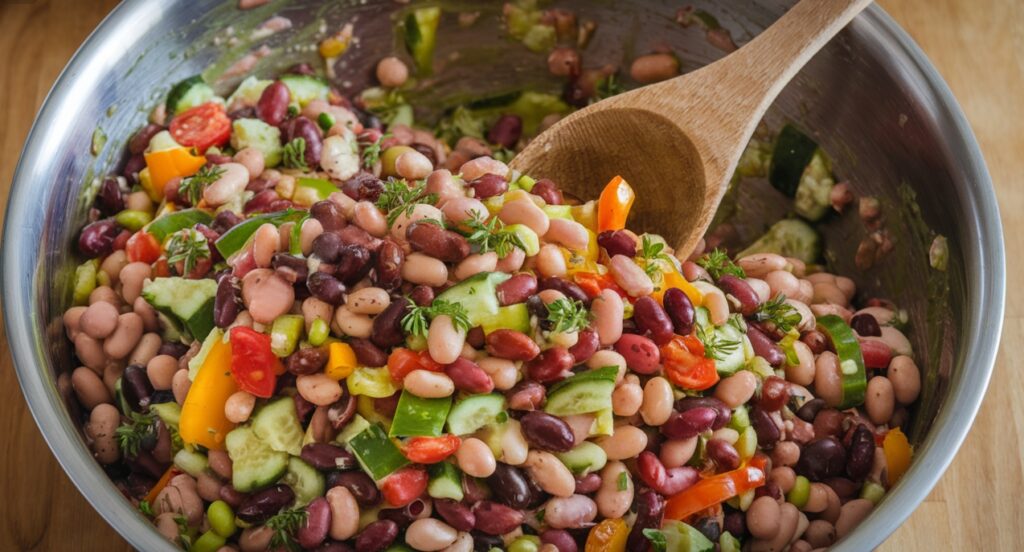Introduction
In the quest for healthier eating habits, you might wonder, “Why should you eat a dense bean salad today?” Packed with protein, fiber, and essential nutrients, a dense bean salad is a versatile and delicious option that fits perfectly into a balanced diet.
This article will dive deep into the nutritional science, health benefits, and culinary creativity of dense bean salads. Whether you’re looking to boost your energy, manage weight, or simply enjoy a flavorful and wholesome meal, this guide will inspire you to embrace the magic of beans. Ready to learn why you should indulge in this superfood-packed salad today? Let’s get started.
Nutritional Power of a Dense Bean Salad
Nutritional Power of Beans
Beans are among the most nutrient-dense foods available, making them an essential component of any balanced diet. In a dense bean salad, the combination of various beans amplifies their nutritional benefits, creating a dish that is not only tasty but also a powerhouse of essential nutrients.

Protein-Packed Goodness
Beans are one of the best sources of plant-based protein, making them a perfect choice for vegetarians, vegans, and anyone looking to reduce their consumption of animal products.
- Protein for Muscle Health: A cup of cooked beans provides approximately 15 grams of protein, contributing to muscle repair and growth.
- Satiation and Energy: Protein also plays a role in keeping you full for longer, which is crucial for avoiding unhealthy snacking.
- Diverse Protein Sources: Combining different beans, such as kidney beans, black beans, and chickpeas, ensures a broader amino acid profile, making your meal even more nutritionally complete.
High Fiber Content
Dietary fiber is one of the standout features of beans. It’s a key player in digestive health and offers several other benefits.
- Digestive Health: Fiber supports a healthy gut by promoting regular bowel movements and preventing constipation.
- Satiety and Weight Management: The high fiber content slows digestion, keeping you feeling full for hours and reducing overall calorie intake.
- Blood Sugar Regulation: Fiber helps stabilize blood sugar levels by slowing the absorption of sugar, making beans a smart choice for people with diabetes.
For reference, a single cup of cooked beans contains 12-15 grams of fiber, which is about half the daily recommended intake.
Vitamins and Minerals in Beans
Beans are a treasure trove of essential vitamins and minerals that support overall health.
- Iron: Beans, especially lentils and black beans, are excellent sources of iron, which is crucial for oxygen transport in the blood. Pairing beans with vitamin C-rich foods (like tomatoes or citrus) enhances iron absorption.
- Magnesium: This mineral plays a vital role in over 300 enzymatic reactions in the body, including energy production and muscle relaxation.
- Folate: Essential for DNA synthesis and repair, folate is particularly important for pregnant women and those planning to conceive.
- Potassium: Beans are naturally high in potassium, which helps regulate blood pressure and maintain fluid balance in the body.
The Nutritional Synergy of Beans
When beans are combined in a dense salad, their nutritional profiles complement each other. For example, chickpeas provide a creamy texture and high folate content, while black beans contribute antioxidants and protein. This synergy not only enhances flavor but also ensures a well-rounded meal.
By incorporating beans into your daily diet through a dense salad, you’re giving your body a boost of essential nutrients in one delicious, easy-to-prepare dish.
Health Benefits of a Dense Bean Salad
Health Benefits of a Dense Bean Salad
A dense bean salad isn’t just a meal; it’s a treasure trove of health benefits that supports various aspects of your well-being. Packed with essential nutrients and bioactive compounds, this dish offers more than just great taste.
Supports Weight Management
Beans are low in calories and high in fiber and protein, making them an ideal food for weight control.
- Calorie Efficiency: Despite being nutrient-dense, beans are naturally low in fat and calories. A cup of mixed beans typically contains just around 200-250 calories.
- Satiety Factor: The combination of fiber and protein promotes a feeling of fullness, reducing the likelihood of overeating during subsequent meals.
- Stabilized Appetite: By helping regulate blood sugar levels, beans prevent energy crashes and hunger pangs, making them an excellent option for those trying to curb cravings.
Research has consistently shown that diets incorporating beans are associated with a lower risk of obesity and better weight maintenance over time.
Boosts Energy Levels
Feeling fatigued? A dense bean salad might be the perfect energy booster. Beans provide a steady release of energy, thanks to their unique carbohydrate structure and nutrient content.
- Complex Carbohydrates: Unlike simple carbs, beans release glucose slowly into the bloodstream, ensuring sustained energy levels throughout the day.
- Iron for Vitality: Iron deficiency can lead to fatigue and lethargy. Beans, as a plant-based iron source, help prevent these symptoms, especially when paired with vitamin C-rich ingredients like bell peppers or lemon juice.
- B Vitamins: Many beans, such as black beans and chickpeas, are rich in B vitamins like folate and B6, which are essential for energy production at the cellular level.
Heart Health Benefits
Including a dense bean salad in your diet can significantly contribute to cardiovascular health.
- Cholesterol Reduction: Soluble fiber in beans binds to cholesterol in the digestive tract, helping reduce LDL (bad cholesterol) levels.
- Blood Pressure Regulation: Potassium and magnesium in beans work together to relax blood vessels, lower blood pressure, and reduce strain on the heart.
- Anti-Inflammatory Effects: Beans contain polyphenols and flavonoids, natural compounds with anti-inflammatory properties that support arterial health and prevent atherosclerosis.
A consistent intake of beans has been linked to a reduced risk of coronary heart disease, making them a smart choice for heart-conscious individuals.
Supports Gut Health
Your gut microbiome—the diverse ecosystem of bacteria in your digestive system—plays a vital role in your overall health. Beans are prebiotic foods, meaning they nourish beneficial gut bacteria.
- Promotes Gut Flora Diversity: The fiber in beans acts as food for probiotics, encouraging the growth of healthy bacteria in your gut.
- Reduces Inflammation: A healthier gut microbiome can lower systemic inflammation, a factor associated with chronic diseases.
- Prevents Digestive Disorders: Regular bean consumption can help prevent conditions like diverticulitis and irritable bowel syndrome (IBS).
A Meal for Longevity
The benefits of beans extend beyond immediate health—they are a key component of the diets of populations in Blue Zones, regions known for their longevity and lower incidence of chronic diseases. A dense bean salad provides an easy, delicious way to incorporate these benefits into your lifestyle.
The Versatility of Bean Salads
The Versatility of Bean Salads
One of the most appealing aspects of a dense bean salad is its incredible versatility. Whether you prefer classic recipes or are keen to experiment with bold flavors, bean salads are adaptable to any palate, dietary requirement, or cultural influence.
Variety of Ingredients
Beans pair beautifully with a wide range of ingredients, allowing for endless customization. Here’s how you can build a nutrient-dense, flavorful salad:
- Vegetables: Crunchy cucumbers, sweet cherry tomatoes, roasted red peppers, and fresh onions add color and nutrients.
- Herbs: Parsley, cilantro, mint, or basil bring a fresh and aromatic touch to your salad.
- Dressings: A drizzle of olive oil and lemon juice or a creamy tahini-based dressing enhances flavor without overpowering the natural goodness of the beans.
- Extras: Add texture and taste with nuts, seeds, or even dried fruits like cranberries or raisins.
This combination of ingredients provides a balance of textures, flavors, and nutrients that make every bite exciting.
Different Global Recipes
Bean salads are beloved worldwide, and each culture has its unique spin on the dish. Here are some inspiring examples:
- Mediterranean-Style Bean Salad
- Features: Chickpeas, cannellini beans, cherry tomatoes, cucumbers, and feta cheese.
- Dressing: Olive oil, red wine vinegar, and oregano.
- Mexican Black Bean Salad
- Features: Black beans, corn, avocado, red onion, and diced jalapeños.
- Dressing: Lime juice, olive oil, cumin, and chili powder.
- Asian-Inspired Edamame Salad
- Features: Edamame, kidney beans, shredded carrots, and sesame seeds.
- Dressing: Soy sauce, sesame oil, and rice vinegar.
- Middle Eastern Fava Bean Salad (Ful Medames)
- Features: Fava beans, chopped parsley, onions, and hard-boiled eggs.
- Dressing: Garlic, lemon juice, and olive oil.
These examples show how beans can be adapted to fit various flavor profiles, making them a universal culinary ingredient.
Easy to Customize
Another advantage of bean salads is their adaptability to dietary preferences and restrictions:
- Vegan: Skip the cheese and use plant-based dressings like tahini or avocado-based sauces.
- Gluten-Free: Beans are naturally gluten-free, so they’re perfect for those avoiding wheat.
- Low-Sodium: Use dried beans and rinse canned beans thoroughly to control sodium content.
- Protein Boost: Add grilled chicken, shrimp, or hard-boiled eggs for an extra protein punch.
Bean salads are also a practical solution for meal prep. They store well in the fridge for several days, allowing you to enjoy a ready-made, nutritious meal whenever you need it.
A Dish for Every Occasion
From light lunches to hearty dinners, bean salads can be scaled up or down depending on the meal. They’re also perfect for potlucks, picnics, and dinner parties, as they appeal to a wide audience and cater to various dietary needs.
How a Dense Bean Salad Boosts Energy Levels
How to Prepare a Dense Bean Salad Today
Creating a dense bean salad at home is easier than you might think. With a few simple steps, fresh ingredients, and a touch of creativity, you can whip up a dish that’s not only delicious but also packed with nutrients.
Step-by-Step Guide
Here’s a simple, foolproof recipe for a dense bean salad:
- Choose Your Beans
- Use a mix of three or more types of beans for a variety of textures and flavors.
- Common options include chickpeas, kidney beans, black beans, white beans, and edamame.
- Opt for canned beans for convenience or cook dried beans for a fresher taste.
- Rinse and Drain
- If using canned beans, rinse them thoroughly under cold water to remove excess sodium and improve flavor.
- For dried beans, ensure they’re soaked and cooked until tender.
- Chop the Vegetables
- Dice a mix of colorful vegetables like cucumbers, cherry tomatoes, bell peppers, and red onions.
- Grate or julienne carrots for an added crunch.
- Add Herbs and Greens
- Toss in freshly chopped parsley, cilantro, or mint for brightness.
- Consider adding spinach or arugula for extra greens.
- Prepare the Dressing
- Whisk together olive oil, lemon juice, a splash of apple cider vinegar, Dijon mustard, salt, and pepper.
- For a creamier dressing, use tahini or Greek yogurt as a base.
- Combine and Toss
- In a large bowl, mix the beans, vegetables, and dressing.
- Toss gently to ensure every ingredient is well-coated.
- Chill and Serve
- Refrigerate the salad for at least 30 minutes before serving to allow the flavors to meld.
Tips for Maximizing Flavor
A dense bean salad is only as good as its ingredients. Follow these tips to elevate your dish:
- Use Fresh Ingredients: Opt for seasonal vegetables and high-quality beans for the best taste and nutrition.
- Don’t Skip the Acidity: A splash of vinegar or citrus juice brightens the salad and balances the earthy flavors of the beans.
- Experiment with Spices: Add cumin, paprika, or za’atar for a flavorful twist.
- Incorporate Textures: Crunchy nuts, seeds, or crumbled cheese can add layers of texture to the dish.
Making It a Balanced Meal
To turn your dense bean salad into a complete, balanced meal, consider these additions:
- Protein Boosts
- Grilled chicken, shrimp, or tofu can add extra protein.
- Hard-boiled eggs or a sprinkle of feta cheese work well for vegetarian options.
- Healthy Grains
- Add cooked quinoa, farro, or brown rice for a heartier dish.
- These grains also contribute additional fiber and complex carbohydrates.
- Healthy Fats
- Include avocado slices or a handful of nuts for healthy fats that support satiety and overall health.
- Drizzle with flaxseed or walnut oil for a nutrient-rich finish.

The Perfect Meal in Minutes
With its quick preparation time and versatility, a dense bean salad is the ultimate meal for busy days. Not only does it come together in under 30 minutes, but it’s also a dish that can be easily scaled to feed a crowd or stored for later enjoyment.
FAQs and Conclusion
Frequently Asked Questions
Why are beans considered a superfood?
Beans are considered a superfood due to their exceptional nutrient profile. They are rich in protein, fiber, vitamins (like folate), and minerals (like iron and magnesium), making them a powerhouse of essential nutrients. Their low-fat content, high antioxidant levels, and ability to improve heart and gut health further cement their superfood status.
Can you eat bean salads every day?
Yes, you can enjoy bean salads daily as part of a balanced diet. Beans are a sustainable source of plant-based protein and fiber, but it’s essential to vary the types of beans and other ingredients to ensure a diverse nutrient intake. For individuals sensitive to beans, soaking them properly or choosing canned options can reduce digestive discomfort.
Are canned beans as healthy as dried beans?
Canned beans are convenient and retain most of their nutrients, making them a healthy option. However, they often contain added sodium, which can be reduced by rinsing them thoroughly. Dried beans, when prepared correctly, may have a fresher taste and lower sodium content, but they require more time and effort to cook.
What beans are best for salads?
Popular beans for salads include:
- Chickpeas: Creamy and mild in flavor.
- Black Beans: Earthy and slightly sweet.
- Kidney Beans: Firm texture and rich color.
- Cannellini Beans: Smooth and nutty.
- Edamame: Vibrant and slightly crunchy.
Each type offers unique flavors and textures, making it easy to mix and match based on your preferences.
How long does bean salad last in the fridge?
A dense bean salad can last up to 3-4 days in the refrigerator when stored in an airtight container. The flavors often intensify over time, making the salad even tastier after a day or two. Avoid leaving the salad at room temperature for extended periods to maintain its freshness.
Can bean salads help with weight loss?
Yes, bean salads are an excellent choice for weight loss. Their high fiber and protein content promote satiety, reducing the likelihood of overeating. Additionally, beans are low in fat and calories, making them a nutrient-dense option for calorie-conscious individuals.
Conclusion
Incorporating a dense bean salad into your diet is one of the simplest and most effective ways to boost your overall health. Beans provide a wealth of nutrients, from protein and fiber to essential vitamins and minerals, while also delivering a host of health benefits, including improved digestion, heart health, and sustained energy levels.
Beyond their nutritional advantages, bean salads are incredibly versatile and easy to prepare. Whether you opt for a Mediterranean-style mix, a spicy Mexican twist, or a simple homemade recipe, there’s no limit to the ways you can enjoy this dish. Plus, with endless customization options, bean salads can fit seamlessly into any lifestyle or dietary preference.
So why not make a dense bean salad today? It’s delicious, nutritious, and a step toward better health—one hearty bowl at a time.




























